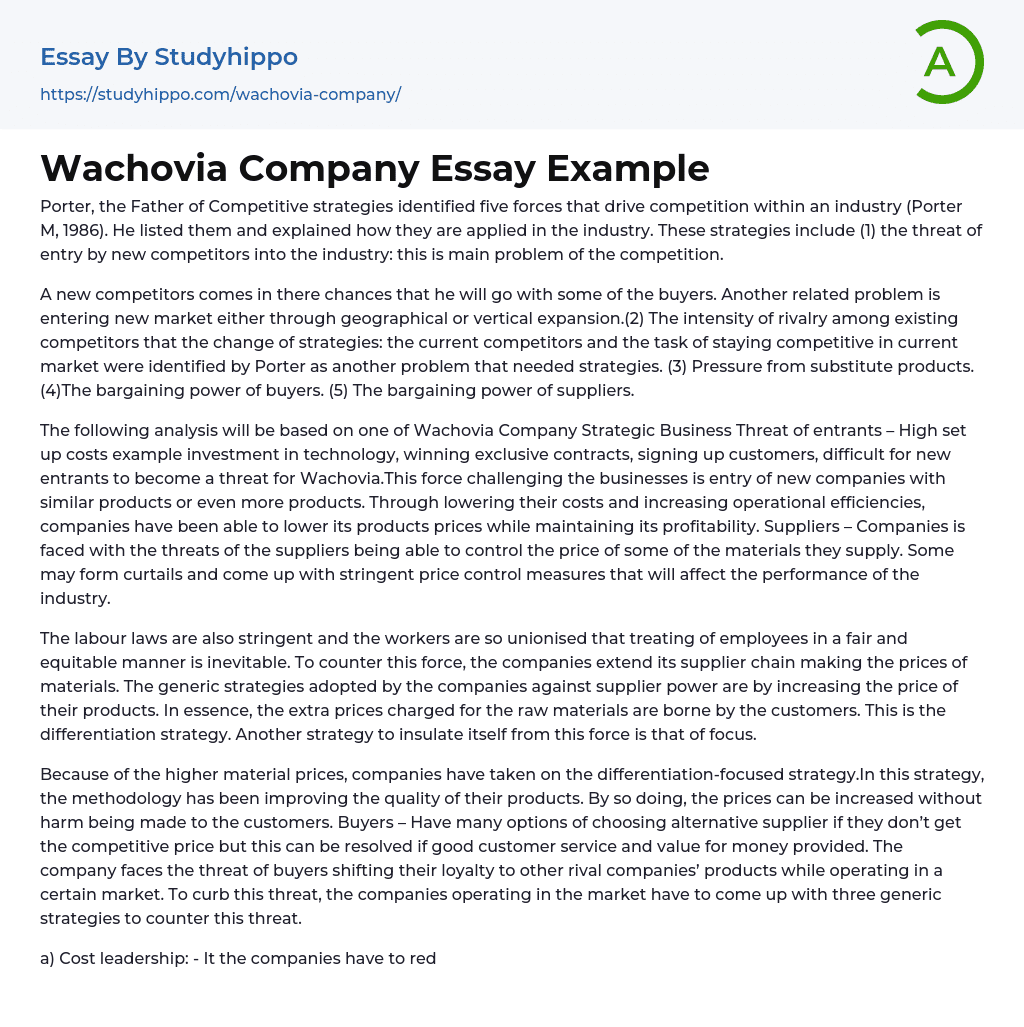Porter (1986), known as the Father of Competitive strategies, identified five driving forces of competition in an industry. He provided a list of these forces and explained their application within the industry. These strategies include:
- The threat of new competitors entering the industry, which poses a major competition challenge. When a new competitor enters, there is a probability that they will attract some of the buyers. Another related challenge is entering new markets through geographical or vertical expansion.
- The intensity of rivalry among existing competitors, which necessitates changes in strategies. Porter recognized that competitors must constantly strive to stay competitive in the current market.
Factors such as substitute products, the bargaining power of buyers, and the bargaining power of suppliers will be analyzed in relation to Wachovia Company's strategic business threat. An example of this is high set up costs, which includes i
...nvestment in technology, winning exclusive contracts, and signing up customers. These forces pose a challenge to businesses with the entry of new companies offering similar or even more products. However, by lowering costs and improving operational efficiencies, companies can reduce product prices while still maintaining profitability.
Suppliers have the power to influence prices of materials, which poses a threat to companies. They may impose restrictions and strict price controls that can adversely affect industry performance. Furthermore, labor laws are stringent and workers are heavily unionized, necessitating fair treatment of employees. To address this challenge, companies diversify their supplier chains to negotiate material prices. Companies employ generic strategies to reduce supplier power by raising product prices. Ultimately, customers bear the burden of additional costs associated with raw materials.
This is the differentiation strategy. Another strategy to insulat
itself from this force is that of focus. Because of the higher material prices, companies have taken on the differentiation-focused strategy. In this strategy, the methodology has been improving the quality of their products, thus enabling them to increase prices without harming customers. Buyers have multiple options when choosing alternative suppliers if they cannot obtain competitive prices, but this can be resolved by providing good customer service and value for money.
The company is at risk of losing customers to competitors in the market. To address this, companies in the market must implement three strategies:
a) Cost leadership: reducing the price of their products is crucial for companies to maintain competitiveness.
b) Differentiation strategy: companies in a particular industry should develop unique products that set them apart from competitors.
The products in question should be both cost-effective and environmentally friendly in terms of pollution and market acceptance. When consumers decide to purchase a specific product, their decision is usually based on the combined value of utility and replacement. Utility value represents the amount that satisfies the consumer's needs, while replacement value refers to the customer's expectations of the product's potential for need satisfaction. Price plays a crucial role in influencing customers, and it is the responsibility of the company's management to determine a price that will attract consumers. If a product lacks good utility value, it is likely to lose purchasing customers, emphasizing the importance of customer purchasing power. Substitutes pose a threat when changes in substitute prices affect the demand for a particular good, creating an elastic price force that companies must combat in order to sustain success in the future.
In order to mitigate the strength
and risk of this force, businesses enhance their differentiation generic strategy within their frameworks. This enables customers to develop loyalty towards the distinctiveness of their offerings. Meanwhile, competition arises from other companies operating in the same industry. The potential threat lies in these companies capturing the market. Nevertheless, the company's strategic approach should be to lower prices whenever confronted with such a threat. Once that company exits the specific market segment, prices can then return to their normal levels.
In conclusion, companies must address the risk of competitors gaining access to their facilities and copying their production methods. To protect their patents and copyrights, it is imperative for companies to ensure that their headquarters are inaccessible to outsiders. Additionally, companies can mitigate the risk of losing employees to rival firms by providing competitive compensation packages. Wachovia exemplifies strategic success in the case study, surpassing its competitors and maintaining a stable position. The company's debt has begun to decrease while revenue and profits continue to rise.
Wachovia's success can be attributed to their focus on addressing and minimizing weaknesses and threats. However, challenges related to the economy and competition remain significant factors. As a result, the company remains committed to offering competitive prices for products and services while acquiring new customers to increase market share. Wachovia implements horizontal integration strategies by transferring experts to underperforming operations, transforming them into profitable business units. The company's strong brand presence also helps overcome entry barriers in foreign markets such as India and China, aligning with international strategic objectives. However, operating in these markets initially faced challenges due to competition from local small companies.
- Bankruptcy essays
- Earnings essays
- Tata Group essays
- S corporation essays
- Secretary essays
- Premise essays
- Adidas essays
- Amazon essays
- Apple essays
- Bmw essays
- British Airways essays
- Burger King essays
- Coca-Cola essays
- Company essays
- Costco essays
- Dell essays
- Ebay essays
- Enron essays
- Facebook essays
- Ford Motor Company essays
- Gap essays
- General Motors essays
- Google essays
- Honda essays
- Ibm essays
- Ikea essays
- Intel essays
- Iphone essays
- Johnson and Johnson essays
- Kellogg essays
- Key essays
- Kfc essays
- Mcdonald's essays
- Microsoft essays
- Myspace essays
- Nestle essays
- Netflix essays
- Nike essays
- Nokia essays
- Pepsi essays
- Pepsico essays
- Red Bull essays
- Ryanair essays
- Samsung essays
- Sony essays
- Southwest Airlines essays
- Starbucks essays
- Supermarket essays
- Tesco essays
- Toyota essays




